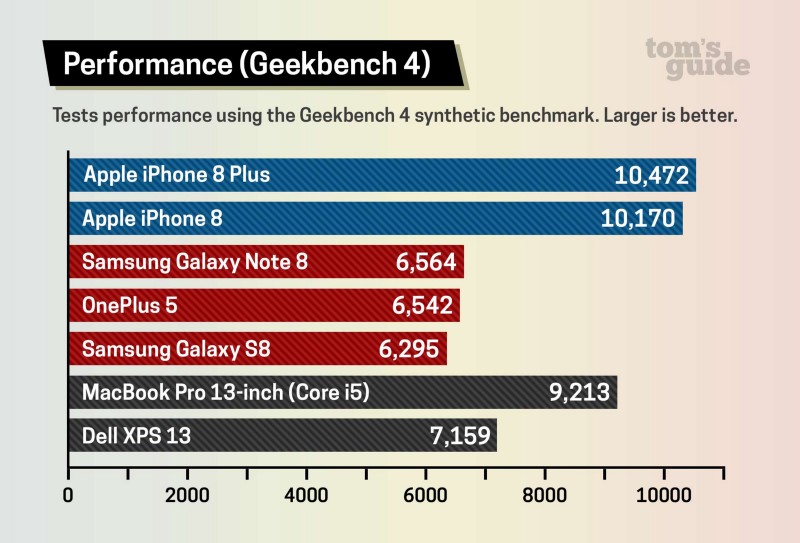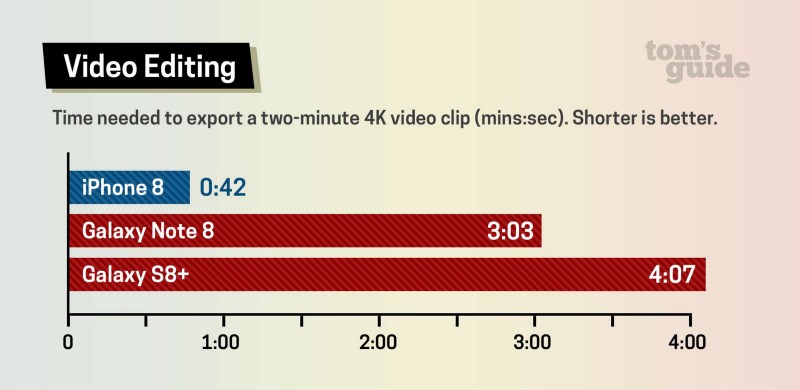Abishek Muthian
Apple’s Chipnomics — How is apple chip faster than the rest
 From Tom’s guide review of iPhone 8
From Tom’s guide review of iPhone 8
Many reviewers have shared benchmark results of the new A11 Bionic SoC (System on Chip) from latest Apple devices & this was not unexpected. I would like to introspect how Apple is managing to build better SoC’s than even traditional chip makers time and again.
Disclaimer : The opinion shared here are personal and doesn’t represent the organisation I represent. Due to the nature our my job, I get to work with different mobile ecosystems and I’m not biased to a single platform. I try my best to credit where it’s due.
As expected Apple’s A11 bionic SoC obliterates the competition not only in mobile (ARM) space, but also even in x86 (computer) space. The interesting fact on how it is able to do so is not some top secret technology which traditional chip makers doesn’t have but purely because of value proposition Apple holds over it’s competition.
Apple has started taking control of its own SoC since A4 (iPad/iPhone 4 –2010 ), seven years later it has complete control over its design with A11 bionic. It has it’s own GPU in A11, that is supposedly 30 % faster & efficient than its predecessor A10’s GPU powered by PowerVR (Imagination Technologies). It also has its own ISP (Image Signal Processor ) for processing Images & Video. It outsources fabrication of its SoC’s to the likes of Samsung Electronics and Taiwan Semiconductor Manufacturing Co Ltd.
How does Apple’s control over it’s design result in better performance ?
The Linely Group published a news letter on how A10 is better than other CPU’s of those time (2016) and had this to say, -
Part of Apple’s advantage is its ability to spend money. Die area is expensive for a processor built in leading-edge 16nm FinFET technology, and Hurricane uses plenty of it. A single Hurricane CPU measures 4.18mm2, about twice the size of other high-end mobile CPUs. Because Apple sells phones, not chips, adding a few dollars of die cost is of little importance if the resulting high performance enables it to sell more $600 products.
In layman terms, Apple makes more expensive chips (in terms of die & fabrication) & it is free to do so since it uses it in it’s own devices. Where as it’s competition buys SoC from a chip maker who has to price it competitively for mass adoption by device manufacturers of different price range.
The reasoning continues to fit for the new A11 which has 64bit 6 core CPU’s manufactured in 10nm FinFET technology. The new CPU has 2 high performance cores & 4 high efficiency cores.
Apple leverages its economical advantage to put money in its SoC design & manufacturing where its competitors would have to place a margin over their SoC’s while managing increasing manufacturing costs.
Did Apple had to do it?
While an average smartphone/tablet user on competitor’s platform wouldn’t miss the beefy performance from the A11. With ARKit / Metal API’s on iOS, developers on iOS platform could leverage the performance to build sophisticated applications.
Having control over their own SoC has let Apple save money. Which is effectively put in the display, camera of their devices and still make way more margin by selling its devices !
Does it mean that the android users will miss all goodies ?
Not necessarily, though the performance of even the highest performing android flagship pales in comparision with A11; android end users aren’t left behind.
The credit of democratising high performance computation goes to Android ecosystem and their SoC’s. With 85% market share, very few developers/publishers now a days think about publishing an iOS only content. A top performing SoC in android ecosystem is available on flagships of varying price range, which should serve most use cases on-par with their A11 counterpart.
At-least that was the case till now.
Update

Patrick Meenan, chrome engineer at Google and developer of famous WebPageTest website test suite says even Apple’s 2015 A9 is better at loading web page in main thread than a high-end Android.
I would love to see a multithreaded test with loading multiple web pages which can make use of OnePlus 5’s massive 8 GB memory, yet still it might not be the general benchmarking case which is applicable to most smartphone users.
If loading web page is faster on 2 year old A9 processor in iPhone than on latest android flagship chipset, then android device manufacturers should seriously concentrate on improving single core performance exponentially.
Theoretically speaking, the more memory on android chipsets could save CPU cycles resulting in lesser power consumption during multitasking as iOS needs to invest it in page compression techniques; then again this is a topic for another time as we’re talking about CPU performance and not memory.
Changing landscape
Since 4K recording capabilities are a norm in today’s high end devices. A significant performance difference here could be very visible to the consumers.
 From Tom's guide review of iPhone 8
From Tom's guide review of iPhone 8
So is the new AR powered gaming and apps which use on device Machine Learning. Google seems to have already started its effort to start building SoC’s to power its devices, when it comes out and if it is as good as AX series ; high performance mobile computing could get lot more interesting.
Till then Apple’s chipnomicsBuy, is set to rule the SoC.
(Btw, I just made the term — Chipnomics).
Buy the items discussed in this post using affiliate links
iPhone
USA India UK Canada Germany Italy Spain Japan France
iPad
Newsletter
I strive to write low frequency, High quality content on Health, Product Development, Programming, Software Engineering, DIY, Security, Philosophy and other interests. If you would like to receive them in your email inbox then please consider subscribing to my Newsletter.